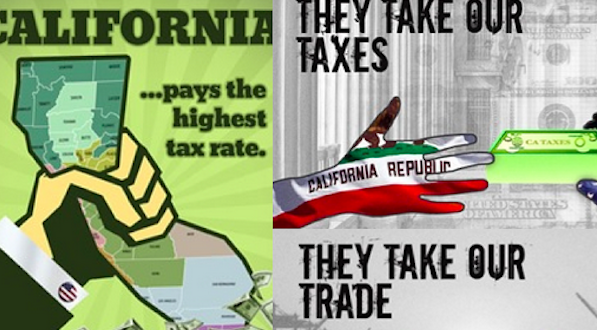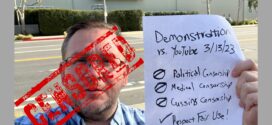By Marcus Ruiz Evans | WeaponizedNews.Com | Jan 15, 2016
It is the beginning of 2016 and two new books just came out describing the dysfunction of California and why it exists. This is an essay comparing these two books’ world views of California.
One of these books, by Victor Davis Hanson, “The Decline and Fall of California: From Decadence to Destruction”, says that California has all of the problems that it does, such as bad roads, and schools, and a deficit, and difficulty paying the bills year after year because of its liberal tendencies to provide a social safety net for is people. Tax the rich to the point of driving out businesses and give the money to the poor who don’t want to work or pay taxes, and generally be unconcerned about the effect of California’s enthusiasm for regulation has on businesses who flee. In truth I have not read Hanson’s book, but I read all of the reviews of this book, and all of the talking points he has released about his book – and the central point of his argument is very clear.
“A half-century of bad policy and failed ideology has reduced the Golden State to a shell of its former glory.”
“Though Californians are overtaxed and over-regulated as a general rule, the state of the infrastructure is in prolific decay. “
“There is a great sickness in California, home of the greatest number of American billionaires and poor people, land of the highest taxes and about the worst schools and roads in the nation,”
“It is a dissection of the rapid descent of the Golden State that stood above all others in power, wealth, and prestige–to a national laughingstock in three generations.”
The other book, of which I was a co-author, by Yes California.org, entitled “California’s future: your guide to independence” talks also about how California has bad roads and schools and trouble with paying the bills, but it places the blame squarely on the Federal government and Federal system of which California is part and not on Californians themselves.
There are many things that both books completely agree on:
- California has a huge homeless and unemployed population
- California does have trouble paying its bills and does have a deficit dragging it down
- The infrastructure to run the California economy is literally falling apart and that is horrible for long term economic health
- Undocumented immigrants do abound in California
- California’s character is historically liberal progressive
After these common consensus points, the two analysis of California seem to absolutely disagree on why California is in the current state it is in. The big difference boiled down is that Hanson places all of the blame on Californians themselves, while Yes California places the majority of the blame on the Federal government.
To repeat I have not read the book, but I wonder if these facts that Yes California is aware of were mentioned at all in the book, because at a minimum they rip up the argument that California’s status to date is completely and totally the fault of Californians. Consider this essay a check list for those of you who do read Hanson’s book. If you don’t see these points brought up – you should take that as either Hanson selected not to bring up these facts, or that he is only capable of sloppy journalism.
Let’s start with this quote, “It is a dissection of the rapid descent of the Golden State that stood above all others in power, wealth, and prestige–to a national laughingstock in three generations.”, which says that California was great in the past and that in roughly three generations or around 30 years California has fallen to the state it is in now. The fact is that California has been a donor state to the Federal government for 30 years, meaning that it pays more into the Federal system than it receives. Typically on order of $60-100 Billion dollars, or the equivalent of a 100% increase of the average California governments’ budget. If you include all of the inflated (not real money) dollars that the Federal Reserve forcibly pumped into the California economy in an effort to stop the spread of the recession caused by Wall St in America, the amount of donations to the Federal system that California receives nothing for – is still around $35 Billion. That is a lot of money, more than enough to fix roads, and infrastructure, improve schools and lower taxes. I wonder if Hanson mentions that California has been a donor state for 30 years, and loses almost the equivalent of one full California government budget every year? Californians do have taxes that are too high – but if we didn’t lose this money, we wouldn’t have to do that. Is that mentioned in Hanson’s analysis? It should be because Governor Schwarzenegger mentioned this very publicly many times, in addition to other elected politicians, and this subject has been repeatedly reported on by California’s government. It’s not a secret.
Hanson places the blame for California’s economy on its behavior toward business; that the state is not friendly enough to businesses and that this is the sole reason why the California economy is not as strong as it could be. I wonder if Hanson mentions that California is vastly more linked to the International trade market than the average American state, and that California routinely has to wait years to have trade deals approved that would bring billions into the California economy. Does Hanson also mention that technology is a huge sector of California’s economy and that California loses billions every year in technology sales because countries won’t buy technology products from California because it is part of America and America (thanks to its own doing – remember the Iraq War and the War on Terror) has a horrible international image. Does Hanson mention that California is a tourism center for the world, and also lost money for the same reason? Does Hanson mention that California is the number one site in the entire world economy for investment and that investment in California has gone down for the same reason that tech sales are down – because of California’s relationship with America.
Hanson talks about the massive amount of poverty and homeless people in California, which it is absolutely true that California has generous benefits for homelessness and that this is a drag on the economy and tax base. I wonder though if Hanson mentions that California only received half of the Federal assistance it was supposed to receive from the Federal government, although California is a donor state and although California has the highest amount of homelessness in all of the American region. I also wonder if Hanson mentions at all that there is an incredible wealth of evidence that the majority of the homeless and poor in California aren’t Californians – they are people who were already poor and homeless and moved to California. These people are not Californians who lived here and then fell on hard times – they are people who came to California to use our system, which means California did not create or make these people poor or homeless. Rather California is covering for America, just as it has for the last 30 years as a donor state. There is good evidence that the states of Nevada, Florida, North Dakota, Hawaii, Illinois, West Virginia, Texas, Massachusetts, Colorado, and Pennsylvania literally ship their homeless and poor and mentally ill people to California. That’s 9 states out of 50 that there is evidence to show this, or almost 20% of America using California as their dumping ground for their own people – that they should take care of. There is strong evidence that California was always seen as a dumping ground and that historically 50% of the homeless in California are not Californians but Americans who traveled here.
Is California a place that is too generous to homeless and poor and too willing to tax businesses and the rich to pay for it, absolutely, but what is also true is that possibly half of the homeless in California are not our responsibility and not people that the California economy made. It’s also true that if California wasn’t financially used by the Federal government for 30 years – we would not have horrible infrastructure, and that we could have lower taxes, and better schools, which would be a huge benefit to the economy and businesses. It’s also true that being connected to America has cost California dearly in the trade, technology, tourism, and foreign direct investment fields. For Yes California and our book which is 165 pages, with 195 citations providing original analysis of the financial usury of the Federal government to California, we think the truth is clear. Even with California’s liberal tendencies – if it was not having to deal with the burden of being connected to America – it would be vastly wealthier and would have the money easily to fix and deal with all of the problems that Hanson rightly notes.
I wonder if Hanson is aware of this truth?
Marcus Ruiz Evans, is the author of “California’s Next Century 2.0” and co-author of the new book “California’s future: your guide to independence”, has studied international trade for the last 10 years, is the Research Director for Yes California.org and is a member of the California Economic Summit “workforce development action team”.
DOWNLOAD YOUR “FREE” COPY OF OUR BOOK: http://www.yescalifornia.org/cf_2016
REFERENCES:
Reviews of “The Decline and Fall of California: From Decadence to Destruction” by Victor Davis Hanson
“The Decline and Fall of California: From Decadence to Destruction” by Victor Davis Hanson, December 2015
“A half-century of bad policy and failed ideology has reduced the Golden State to a shell of its former glory.”
“Though Californians are overtaxed and over-regulated as a general rule, the state of the infrastructure is in prolific decay. How can this be? Hanson writes that while their forefathers created an incredibly efficient system of infrastructure and water management, Californians reversed this trend in the 1970s—they opted for low-growth, environmentalist policies that simply could not handle an explosion in population.”
“There is a great sickness in California, home of the greatest number of American billionaires and poor people, land of the highest taxes and about the worst schools and roads in the nation,”
“It is a dissection of the rapid descent of the Golden State that stood above all others in power, wealth, and prestige–to a national laughingstock in three generations.”
“Review—The Decline and Fall of California: From Decadence to Destruction” by Jarrett Stepman, Breitbart December 9 2015
http://www.breitbart.com/california/2015/12/09/review-the-decline-and-fall-of-california-from-decadence-to-destruction/
“The Decline and Fall of California: From Decadence to Destruction: New E-Book from PJ Media Provides Unique Glimpse into How California’s Prosperity has Eroded” by PR News Wire, December 1 2015
http://www.prnewswire.com/news-releases/the-decline-and-fall-of-california-from-decadence-to-destruction-300185424.html
“Hanson’s book makes it clear that the increasingly dystopian California has been the author of its own decline”
“Conservatives lost. Liberals won– by a combination of flooding the state with government-supplied stuff, and welcoming millions in while showing the exit to others.”
“The agricultural heart of the state has dried up, the middle-class has fled to more favorable tax environments, and new, mostly illegal immigrants – who come in droves due to the open borders policies of the state’s elites”
“Hanson on California: The picture is bleak” By Carol Brown, American Thinker, December 10, 2015
http://www.americanthinker.com/blog/2015/12/hanson_on_california_the_picture_is_bleak.html#ixzz3xG9Pn18S
California is a donor state and loses multiple billions of dollars every year because it pays more into the Federal system than it ever receives, and this has gone on for 30 years.
“Washington fires back at Schwarzenegger: U.S. legislators say criticism over funding is an attempt to deflect blame for state’s budget problems.” By Michael Rothfeld and Richard Simon, LA Times, January 12, 2010
http://articles.latimes.com/2010/jan/12/local/la-me-arnold12-2010jan12
“Why Do Some States Feast on Federal Spending, Not Others?” by Andrew Chamberlain, March 16, 2006
“Federal Taxes Paid vs. Federal Spending Received by State, 1981-2005” by Tax Foundation, October 19, 2007
http://taxfoundation.org/article/federal-taxes-paid-vs-federal-spending-received-state-1981-2005
“Arnold Schwarzenegger isn’t the first California governor to complain that the state gets shortchanged in federal funding. California contributes more than its share in federal taxes and gets less than its share in federal programs, contracts and aid. But in a severe state budget crisis, the inequities, easy to slough off in good times, become harder to ignore and the injustice more infuriating.”
“What The Feds Owe Us, And What We Owe Ourselves” by Pete Shrag, California Progress Report, 2009
http://www.californiaprogressreport.com/site/node/7273
“California Institute Special Report: California’s Balance of Payments with the Federal Treasury, Fiscal Years 1981-2002” by California Institute for Federal policy research, 2002
http://www.calinst.org/pubs/balrpt02.htm
“Speier Calls on President Bush to Pay $6.5 Billion Tab” By Jackie Speier, October 3 2006
http://www.californiaprogressreport.com/site/speier-calls-president-bush-pay-65-billion-tab
“Schwarzenegger Calls Out Federal Government, Asks For Aid” by Special To Personal Liberty, January 12, 2010
http://personalliberty.com/schwarzenegger-calls-out-federal-government-asks-for-aid-19545881/
Yes California.org calculates that currently, even with inflationary spending to boost the economy California still loses $35B each year to the federal network as a donor state
http://www.yescalifornia.org/cf_2016
California loses billions in lost international trade because it has to gain approval from the Federal system to execute trade deals, and the Federal system of approving international trade is inefficient and routinely hurts California
“…a long standing but inadequately understood and therefore often ignored reality – that international trends, events, relationships and policies greatly affect California and its distinct regions, and that Californians therefore have important international interests.” pg 80
“Although Californians have important international policy interests, we do not have systemic ways to identify, rank and pursue them.” Pg 81
“Californians have important international interests but cannot pursue most of them effectively through state public policies.” Pg 125
“Yet, even with such an abundant evidence of California’s expanding global ties an stakes, and of the benefits and costs of international engagement, little systematic policymaking or even policy analysis has been done over the years about the issues posed for California by world trends, threats and opportunities.” Pg 11
“In part, the absence of significant California focused consideration of international issues, relationships and policy choices owes to the traditional tendency to think of “foreign policy” and external relations as exclusively managed by the federal government in Washington. A priestly tribe of experts from the law firms, corporations, universities and think tanks of the Atlantic coast – residing from Boston to Washington…” pg 12
“California is faced with a structural gap between its high stakes in the realm of international policy and the modest scope for authorized direct action.” & “Californians have important international interests but cannot pursue most of them effectively through state public policies.” Pg 125
“Global California: rising to the cosmopolitan challenge” by Abraham Lowenthal, 2009
“Relative to most nations, the US has a cumbersome structure for formulating and implementing trade policy…Trade policy is usually ad hoc, set through responding to individual cases.”
“The competitive advantage of nations” by Michael Porter, The free press, 1990, pg 733
“U.S. states have, of course, noticed this trend such that a senior California trade official says U.S. officials “are anxious to see the states increasingly involved in trade promotion but not in the trade policy area”
“Managing Foreign Relations in Federal States: Linking Central and Non-Central International Interests” In Foreign Relations and Federal States, edited by Brian Hocking, 1993, pg 73
“Finally, [Federal] export-promotion strategies are often a response to political pressures instead of smart trade policy, a mistake to avoid repeating in California.”
“Strategies for Expanding California’s Exports” by Kevin Klowden and Michael Wolfe, Milken Institute, 2012, pg 13
President Obama in his 2011 state of the Union address, said that Americas trade infrastructure is bloated, in comparison to other nations, America has 12 different agencies that have to be consulted for any trade deal.
“Citizenville” by Gavin Newsom, 2013, pg 9
“Schwarzenegger: Congress Stalling On Free Trade Agreements” by Kelly Olsen, 2010, Huffington post
http://www.huffingtonpost.com/2010/09/15/schwarzenegger-congress-s_n_717474.html
“Washington doesn’t sincerely want jobs” Posted By Clyde Prestowitz , 2011, foreign policy
http://www.unz.org/Pub/ForeignPolicyWeb-2011aug-00032
“Schwarzenegger urges Congress to ratify free trade deals at end of Asian tour”, 2010, Topix.com
http://www.topix.com/forum/state/ca/TRO1E1OCJR5KVPUES
“Blue Diamond Growers” What a California almond company can teach us about the globalization of American agriculture.” By Martha C. White 2010, Slate.com
http://www.nationalpost.com/related/topics/What+California+almond+company+teach+about+globalization+agriculture/3783628/story.html
“Failed South Korean trade deal a setback for Obama” 2010, Cleveland.com
http://www.cleveland.com/world/index.ssf/2010/11/failed_south_korean_trade_deal.html
As an example California loses around $6B in lost technology sales because of its association with America
“Study: Surveillance will cost US tech sector more than $35B by 2016” By David McCabe, September 6 2015
http://thehill.com/policy/technology/244403-study-surveillance-will-cost-us-tech-sector-over-35b-by-2016
California has 1.1 million of 6.5 million total technology workers.
“United States Tech Industry Employs 6.5 Million in 2014” by CompTIA, Feb 10, 2015
https://www.comptia.org/about-us/newsroom/press-releases/2015/02/10/united-states-tech-industry-employs-6.5-million-in-2014
Another example is the investment in California dropped because of association with America
“US FDI inflows continue to fall, Presidents job council recommends ways to reverse trend” Global FDI, accessed October 9 2011
http://goo.gl/prT2TH
Another example is that travel to California dropped because of association with America
International travel to America from the rest of the world from 1992 to 2005 has dropped 38%.
“US tourism ‘losing billions because of image’ “ by Amy Yee, Financial Times, May 8 2005
http://goo.gl/937ish
Part of the reason homelessness and unemployment are so high and horrible in California is that even though California gives $35-100 Billion more to the Federal government than it receives every year, it only received half of the Federal assistance it deserved for homelessness.
“Not surprisingly, California has failed to receive federal support for the problem in a proportional fashion. The report noted that despite having 21% of the nation’s homeless students, it receives about 11% of federal funds from the McKinney-Vento Homeless Education Assistance Act.”
“California Leads the Nation in Homeless School Children” By Ken Broder, All Gov.com, October 08, 2014
http://www.allgov.com/usa/ca/news/california-and-the-nation/california-leads-the-nation-in-homeless-school-children-141008?news=8544
“California has the largest population of homeless students in the country and twice the rate of homeless students as the national average” (pg4)
“As California’s population of homeless students rises, the funding to meet their needs has not kept pace. The U.S. Department of Education allocates McKinney-Vento funds according to a formula based on poverty, without reference to the number of homeless students the state identifies. In the 2011-2012 school year, California schools identified 21% of the homeless students nationwide, yet received only 11% of the available federal McKinney- Vento funds.” (pg4)
“California’s Homeless students: a growing population: By Shahera Hyatt, MSW; Brynn Walzer, MSW; and Patricia Julianelle, JD, California Homeless Youth Project, California Research Bureau, California State Library, September 2014
http://cahomelessyouth.library.ca.gov/docs/pdf/CaliforniasHomelessStudents_AGrowingPopulation.pdf
“approximately one-third [of chronic homeless are] in California alone. However, the nation’s permanent supportive housing inventory is distributed fairly evenly across the United States.”
“People Experiencing Chronic Homelessness” by United States Interagency Council on Homelessness: Chronic Homelessness in Focus.
http://usich.gov/population/chronic/in_focus/
The big question to answer when talking about the welfare system, social safety net offered by Californians is – how many of the homeless and poor are actually Californians and how many are people who came to California with only the intention of using the system.
CA and FL were in a class by themselves compared to the entire rest of the US in holding the chronic homeless population. Why would so many people who are consistently homeless find themselves in the two sunshine states? Either they moved there, or there is something about the CA and FL economy where they just generate homelessness beyond comparison to other states. This is unlikely given that Florida is a socially and fiscally conservative state while California is the complete opposite as a socially liberal and fiscally liberal state. How could two places with completely different ideologies to the social safety net and the economy both suffer from chronic homelessness unless the weather is the actual cause of why a state may have a above average homeless population.
“Defining Chronic Homelessness: A Technical Guide for HUD Programs” by Office of Community Planning and Development Office of Special Needs Assistance Programs, September 2007
https://www.hudexchange.info/resources/documents/DefiningChronicHomeless.pdf
It has also been proven that poor people move to areas where there is a lot of poverty because they feel that they will be given sympathy. The two poorest parts of California that drag down the rest of the California economy are in the Central Valley and Inland Empire, and yet after the recession of 2008, these two areas experienced the highest growth anywhere in California – meaning that people were specifically moving to the two poorest areas after the recession hit. Who were these people?
“Attracted by low-cost housing and low-skill jobs, poor people move disproportionately to rural communities. Rural places are poor in part because poor people move there.”
“Poor People are Moving to Already Poor, Rural Communities” By Bill Bishop, Growth and Development | Main Street Economics, 09/27/2007
http://www.dailyyonder.com/poor-people-are-moving-already-poor-rural-communities
“Why Do Americans Move From Wealthy States to Poorer Ones?” By Peter Coy, Bloomberg, January 09, 2014
Inland Empire, and Central Valley counties to be the fastest growing regions in California – just two years after the start of the recession.
“…with higher growth in the Central Valley and inland parts of Southern California.”
“Census 2010: Bay Area slower-growing, more diverse” By Matt O’Brien, Contra Costa Times, 2010
http://www.mercurynews.com/ci_17569154?IADID
“Census shows Central Valley areas among poorest in nation” by Associated Press, 2012
http://www.mercurynews.com/ci_21596949/central-valley-areas-among-poorest
“Census: Inland Empire has nation’s highest poverty rate” By Neil Nisperos, Ryan Hagen, The Sun, 2013 http://www.sbsun.com/social-affairs/20130919/census-inland-empire-has-nations-highest-poverty-rate
Nevada’s government has been caught dumping homeless in California
“San Francisco Investigates Alleged Patient Dumping By Nevada Hospital” by CBS Tv, April 22, 2013
“Nevada buses hundreds of mentally ill patients to cities around country” By Cynthia Hubert, Phillip Reese and Jim Sanders, Sacramento Bee, April 14, 2013
http://www.sacbee.com/news/investigations/nevada-patient-busing/article2577189.html
Florida, North Dakota, Hawaii bus/fly people anywhere they want to go – many choose CA, just can say they have family there.
“Florida City To Provide 1-Way Bus Tickets For Homeless People” By Robbie Couch, The Huffington Post September 5 2014
http://www.huffingtonpost.com/2014/09/05/sarasota-homeless-bus_n_5766616.html
“Homeless In Williston, North Dakota Get One-Way Bus Tickets Out Of City From Salvation Army” By Eleanor Goldberg, The Huffington Post, January 11 2013
http://www.huffingtonpost.com/2013/01/11/homeless-bus-tickets_n_2458344.html
“Hawaii Offers Homeless One-Way Tickets Out of State: The controversial tactic has been tried — and vocally criticized — elsewhere” By Olivia B. Waxman, Time, July 31, 2013
http://newsfeed.time.com/2013/07/31/hawaii-offers-homeless-one-way-tickets-out-of-state/
“[2009] Andrea and Greg Killgore were already living on the streets in Las Vegas when they decided to relocate to Lancaster in early March. They thought their job prospects would be better in California.”
“Homeless receive free one-way tickets out of Lancaster: Nonprofit pays for people to bus to places where they have family or other support systems. Mayor R. Rex Parris says Lancaster has become a ‘dumping ground’ for other cities’ homeless” by Ann M. Simmons, March 30, 2009
http://articles.latimes.com/2009/mar/30/local/me-buspass30
“Why do red states ship their homeless to California? Isn’t that passing the buck to California? Does that really solve anything?” by Yahoo Answers, 2012
“The problem, Kayhan [SF Mayor director for homeless policy] says, is that San Francisco has become a clearinghouse for other cities and states.”
“People are coming from all over,” Kayhan said. “I am seeing it firsthand. I often hear that this city or that city’s homeless plan is a bus ticket to San Francisco.”
“My anecdotal data is that 8 out of 10 of those I speak to on the street are from somewhere else,” Kayhan said. “Last week I went to a homeless encampment just off Mission and Ninth. There were seven homeless guys there, and when I asked them where they were from they said: Marin, Chicago, West Virginia, Santa Rosa, Texas, San Diego and Boston.”
“S.F. blames out-of-towners for endless homeless problem” By C.W. Nevius, SF Gate, December 20, 2008
http://www.sfgate.com/bayarea/article/S-F-blames-out-of-towners-for-endless-homeless-3257556.php
“After the one-night count on Jan. 31, in a follow-up survey of homeless people, 31 percent noted that they became homeless outside San Francisco.
“That is close to a third of the people we counted,” says Trent Rhorer, director of the San Francisco Human Services Agency. “It begs the question of why they came here; I don’t know that the answer is necessarily one of homelessness.””
“SAN FRANCISCO / City attracts homeless for more than one reason / They come for its tolerance, diversity as well as programs” by Elizabeth Fernandez, San Francisco Chronicle, March 30, 2007
http://www.sfgate.com/bayarea/article/SAN-FRANCISCO-City-attracts-homeless-for-more-2606318.php
Talks about how it’s tradition in Colorado to ship homeless to California
“Night of the Living Homeless” South Park,
http://southpark.cc.com/clips/104429/look-glenn-were-saved
Talks about how it’s tradition in Pennsylvania to ship homeless to California
“Return of Psycho Pete” Always Sunny in Philadelphia
http://community.ew.com/2015/01/28/psycho-pete-returns/
 Weaponized News New World Order politics, economics and current events
Weaponized News New World Order politics, economics and current events










